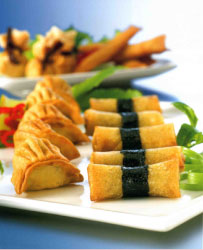Farewell to finger food as cutlery reappears at private parties
 Hamburg - A bite of food here, an appetizer there and finally a skewer full of grilled meat or vegetables: Finger food is still served at company parties and private gatherings.
Hamburg - A bite of food here, an appetizer there and finally a skewer full of grilled meat or vegetables: Finger food is still served at company parties and private gatherings.
But no trend can go on without some backlash, especially from party-goers who have difficulty guiding shrimp cocktail and potato skins into their mouths solely with the help of a napkin or toothpick.
Thus, cutlery is coming out of the shadows gradually - knives, forks and spoons currently are being given a new position of honour on beautifully set tables.
Stylistically, modern cutlery with simple design features and plain, clear forms are most popular, said Jens-Heinrich Beckmann, director of the German industrial association for household wares in Solingen. But Chippendale, Rococo and other elaborate designs also are popular, Beckmann said.
But one thing that's becoming less common is having one set of cutlery for everyday and one for special occasions.
"Silverware previously was a status symbol, a sign of someone's rise up the social ladder," said Beckmann. "These days silverware is used regularly, which has a great advantage: The silver doesn't tarnish," he added.
Seating guests at a properly set table with knives and forks is not really such an old tradition.
"Here in Germany it has been the custom for only about 150 years that there is a set of cutlery for every guest," said Imme Vogelsang, a manners trainer in Hamburg. Prior to that guests shared the cutlery. Guests also commonly ate with their fingers. For a long time there were only spoons and knives on the table. "In Germany the fork was considered a tool of the devil," said Vogelsang.
The most important advice for customers buying cutlery is to hold it in their hand, said Curt Mertens, an expert on cutlery and the chief executive of the Carl Mertens cutlery factory in Solingen. The design has important influence on how one eats, said Mertens. Therefore, not only the look of the cutlery has to suit. Knives, forks and spoons should sit well in the hand, should not be too large or too small, not too heavy and not too light.
If the design is pleasing and the cutlery has a good feel, then the only question remaining is the quality. This is often difficult for lay people to estimate.
"At first glance, cheap cutlery often appears no different than expensive cutlery," said Beckmann. The popular material used today is precious metal. An indication of quality is the 18/10 stamp on the cutlery.
"That means that the chrome portion is 18 per cent and the nickel portion is 10 per cent. The remaining 72 per cent is iron," said Bernd Wiedenhoefer of German manufacturer WMF of Geislingen/Steige. While chrome makes the cutlery rust-free, the nickel makes it acid resistant and gives it a shine.
People with allergies need not worry about the nickel content. According to Beckmann, it is not coated in nickel, rather the metal is alloyed, and the nickel cannot loosen.
Knives are distinguished by the two ways in which they are made - solid or hollow. The solid type, also called monobloc, are formed out of a single piece of metal. Their blades are pressed in an embossing dye. Hollow knives have a forged blade that is set into the handle, Beckmann explained.
The hollow-handle knives have the advantage of a harder blade that generally is not warped. They can be identified by a small seam between the blade and the handle. If no seam or transition is noticeable, then blow on the knife and if they are made of two parts there will be a difference in the condensation.
When examining forks, it's worth looking between the prongs. If the fork has been smoothed and polished well there, it is a sign of quality, said Wiedenhoefer. Polishing can be done by machines nowadays, but it is still expensive to do. Cheaply made forks are only superficially polished in between the prongs and the surface is rough compared with other parts of the fork. That leaves it susceptible to rust.
Finally, when examining the spoons, check for rough edges that can take the fun out of eating. (dpa)
